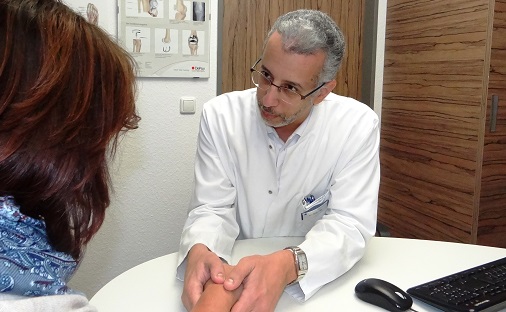Synovektomy
At an early stage, Synovectomy alleviate Patient symptoms and prevent damage of the cartilage and preserve joint function.
Medical Focus
Orthopedic Rheumatology

Rheumatoid arthritis is an autoimmune disease which causes inflammation of the synovium of the joints as well as the tendon sheaths. This is not a limited disease but a chronic, relapsing progressive systemic disease. The hand and wrist are the most common affected joints in the body.
Pathophysiology
In the early phase, there is a proliferation of inflammatory joint sense of synovium and tendon sheaths. This causes swelling and pronounced pain. In the absence of treatment inflammatory tissue migrates into the articular cartilage and destroys these, resulting in the late phase to osteoarthritis and later to complete destruction of the joint. The ligaments and tendons are damaged, resulting in misaligned and stiffness of the joints and tendon rupture. In the final stage, there is a complete loss of function of the joint.
Therapy (Conservative treatment)
In early stages of the disease, treatment with anti-inflammatory drugs by a rheumatologist is the treatment of choice. Thus, the inflammatory process is interrupted or at least slowed down. Early diagnosis and adequate treatment by a rheumatologist positively affect the course of the disease.
Therapy (Surgical treatment)
In case of insufficient effect of drug therapy or already advanced disease, it is important not to delay the step to a surgical therapy.
Depending on the stage of the disease, there are different surgical methods. The decision is taken individually taking into account the affected joint, the present damage and the needs of the patient
In cases in late Stages with progressive destruction of the joint , deformities or tendon tears, attempts must be made to correct the deformity and restore joint function as possible.
- Resection interposition Arthroplasty (RIAP)
In this procedure, a partial removal of a damaged joint and lining of the cavity is made with body tissue. This is indicated especially in the joints with low stability and high mobility needs with good postoperative results. - Joint replacement
It is indicated in cases with damaged joint with the presence of intact tendons and muscles. - Arthrodesis
Fixation of the joints in functional positions is indicated in cases with heavily damaged joints, with instability or malalignment. It is a highly reliable procedure with excellent pain relief, secure joint stability and a high degree of satisfaction among patients.

